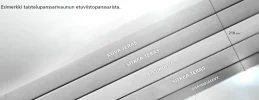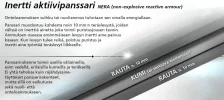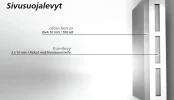Jos olen käsittänyt keskustelun oikein, niin tässä tapauksessa isoin merkitys on sillä, että miehistö on sen moottoritilan verran kauempana läpäisypisteestä. Ei sen moottorin sisältämällä metallilla sinänsä. Mutta luulen että aina se moottorikin jonkin pienemmän sirpaleen pysäyttää.Mutta jos osuma tuleekin RPG;stä? Ei taida läpäistä panssarin JA moottorin?
Install the app
How to install the app on iOS
Follow along with the video below to see how to install our site as a web app on your home screen.
Note: This feature may not be available in some browsers.
You are using an out of date browser. It may not display this or other websites correctly.
You should upgrade or use an alternative browser.
You should upgrade or use an alternative browser.
Panssarivaunut
- Viestiketjun aloittaja ctg
- Aloitus PVM
-
- Tagit
- panssarivaunut
Materiaaliteknisenä välihuomautuksena, moottorilohkoilla ym. ei tosiaan ole juuri mitään panssariarvoa sinänsä. Jos vaikka Merkavasta tulee etusektorista nuoli sisään niin se jatkaa matkaansa aika samalla tavalla riippumatta siitä, olisiko moottori paikallaan vaiko ei.
Mitä on "ei juuri mitään panssariarvoa"? Esim. SI-yksikköinä, tai prosentteina?
- Kai siinä on kuitenkin varmaan kymmeniä senttimetrejä metallia välissä?
- Tietysti ei varmaan yhtä hyvää kuin panssariteräs. Mutta eiköhän se moottorikin ole aika hyvää kamaa. Tiheyshän on tärkein tekijä, jos moottori ei ole alumiinivalua, niin luulisi vaikuttavan
- Lisäksi pitkä etäisyys ja ilmareiät vaikuttavat paremmin kuin yhtenäinen pansssari
- Parhaimmillaan moottorin liikkuvat osat voivat toimia kuin esim. Leon reaktiivinen panssarointi tornissa
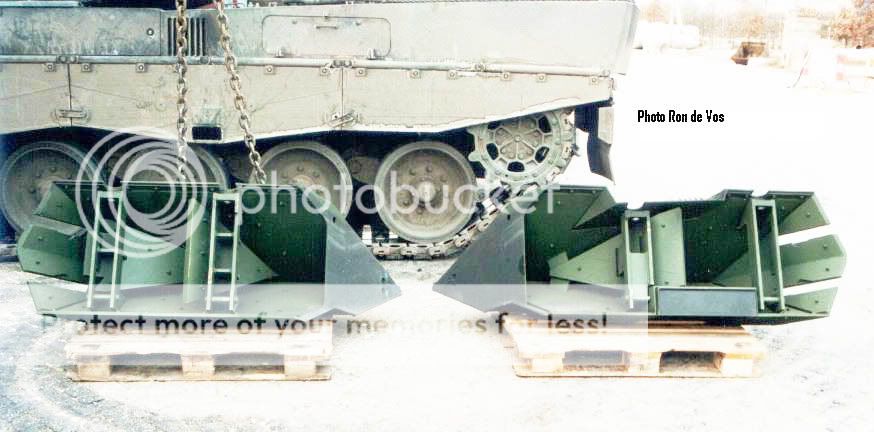
Einomies1
Respected Leader
Tässä juttua Libanonin kokemuksista ja Merkava 4:n suojauksesta:Merkava nelosia meni kaksi palasiksi, joista molemmat tuhoutuivat muistaakseni sodan lopussa paska olmertin kyvyttömyyden takia. Vaunut ottivat osumaa uusista venäläisistä ohjuksista tornin kattoon.
Muut kärsineet merkavat olivat kolmosia, niistä suurinta osaa ammuttiin takaa. Jokainen merkava otti useita osumia, osa syttyi palamaan, vaunut eivät silti tuhoutuneet, vain kahden vaunun miehistöt kaatuivat.
Muutenkin paikka jossa merkavat menetettiin oli kristitty kylä, ja sen oli annettu olla rauhassa. Oli myös sodan viimeinen päivä, ja olmert ei ole sotilas vaan (kämänen tiedottaja ollessaan intissä) tahtoi väkisin painaa päälle.
Tappiot oli 8 kaatunutta vaunumiestä ja 4 kaatunutta jalkaväkimiestä, sekä useita haavoittuneita jv miehiä. Eikä hyökkäyksestä ollut yhtään mitään hyötyä.
Mitä taas tulee koneen sijaintiin merkavissa, niin jo suunnitteluvaiheessa on otettu tärkeimmäksi asiaksi miehistö ja sen hengissä selviäminen. Pattoneissa ja centaureissa miehet yleensä kuolivat vaunujen mukana, mikä on aina pienelle valtiolle paha asia. Uusia vaunuja saa, mutta miehet pysyvät kuolleina. Merkava pystyy myös kuljettamaan tarvittaessa haavoittuneita, tai ihan jv ukkeleita "muuten" vaan.
Sisälle/ulos pääsee tarvittaessa kätsysti takaa
http://defense-update.com/analysis/lebanon_war_3.htm
Tube-pätkä on kopio Al-Jazeeran jutusta joten kannattaa tietysti suhtautua varauksella joihinkin asioihin siinä.
Defence-Update-sivuston mukaan Merkava 4 osoitti toimivuutensa kentällä tappioista huolimatta ja pelasti paljon miehiä. Jos vaunuissa olisi ollut sensoreita ja aktiivisia puolustusjärjestelmiä, olisi tappiot jääneet vieläkin pienemmiksi. Näitä oli jätetty asentamatta säästösyistä. Muut vaunut kärsivät vielä enemmän tappioita.
Tunnetun tiedon perusteella hyökkäys noin hankalassa maastossa joka ei suosi panssarijoukkojen käyttöä, valmistautunutta panssarintorjuntaa vastaan oli selvä taktinen virhe. Vaunuja kohden ammuttiin satoja ohjuksia ja Hisbollah oli hyvin varustaunut ja panssarintorjunta tehokkaasti johdettu jolloin hyökkääjään saatiin tehokas vaikutus. Tämä saavutettiin ilman epäsuoran tulen tukea mikä on merkittävä seikka mielestäni.
Vaikka Israelilaiset tekivät virheitä ja kalustossa oli puutteita, ei tämä ollut ainoa syy tappioon. VAstapuoli oli kehittänyt panssarintorjunnan tehokkaaksi, hyvin johdetuksi ja lukumäärältään suureksi tekijäksi. Puolustajaa suosivassa maastossa Israelin hyökkäykset pysäytettiin ja niille aiheutettiin riittävästi tappioita. Seikka joka on syytä huomioida kotimaassakin!
Vaikka Merkava 4 on erinomainen tankki, ehkä parhaita koskaan ja suojaa miehistöään erinomaisesti oli jokainen vaurioitunutkin tankki (taistelukyvytön) ongelma hyökkääjälle ja voitto puolustajalle. Puolustajan näkökulmasta on melkoisen sama tuhotaanko tankki kerralla vai vaurioituuko se pahasti ja kaatuuko vai haavoittuuko sen miehistö osittain/kokonaan. Liikuntakyvytön vaunu jossa on vielä haavoittunut miehistö, ei kykene jatkamaan hyökkäystä ja sen miehistön pelastaminen hidastaa ja hankaloittaa joukon toimintaa. Vaunu pitää jokatapauksessa hinata pois jos mahdollista korjattavaksi eikä siitä ole välttämättä palaamaan kentälle viikkoihin.
Tietyssä mielessä on jopa puolustajan/torjunnan kannalta parempi että hyökkääjän vaunujen miehistöstä haavoittuu enemmän porukkaa kuin kuolee koska haavoittuneet pitää hoitaa ja evakuoida nopeasti ja se on taistelussa aina hankalaa. Parhaimmillaan vaurioitunut vaunu vetää lähistölleen muita joukkoja/vaunuja joihin saadaan ehkä vielä paremmin vaikutusta.
Kukaan ei jätä haavoittuneita kavereitaan kuolemaan hoidon puutteeseen taistelussa, se on selvä koska muuten myös taistelumoraali laskee joukoissa.
Niistä kuvista ja jutuista mitä olen panssarisodasta nähnyt, miehistön vammat ovat lievimmilläänkin melko hirveitä joten vaunumiehistö ei välttämättä pääse enää taisteluun vaikka selviytyisikin yhdestä taistelusta hengissä. Henkisten vammojen osuus on myös huomioitava jolla on vaikutusta taistelumoraaliin.
Bemarimies
Kersantti
Kyllä moottori ja vaihteisto ovat verrattain hyvää panssaria. Sirpaletta ne kestävät (lohkon ja kannen alueelta) siinä missä keskiverto APC:n kylki. Ontelosuihkua vastaan moottorin rakenne on lähes ihanteellinen: On jäähdytysneste tilaa, kuoren valurautaa, sylinteriputkea, ilmatilaa kutakin vuorollaan ja moneen kertaan. Tätä siis riittää esim CV:n DC16 V8 moottorissa pituussuunnassa noin yli metrin ja leveys suunnassakin korkeudesta riippuen parhaimmillaan yli metrin.Mitä on "ei juuri mitään panssariarvoa"? Esim. SI-yksikköinä, tai prosentteina?
- Kai siinä on kuitenkin varmaan kymmeniä senttimetrejä metallia välissä?
- Tietysti ei varmaan yhtä hyvää kuin panssariteräs. Mutta eiköhän se moottorikin ole aika hyvää kamaa. Tiheyshän on tärkein tekijä, jos moottori ei ole alumiinivalua, niin luulisi vaikuttavan
- Lisäksi pitkä etäisyys ja ilmareiät vaikuttavat paremmin kuin yhtenäinen pansssari
- Parhaimmillaan moottorin liikkuvat osat voivat toimia kuin esim. Leon reaktiivinen panssarointi tornissa

Nuoliammusta vastaan moottori toimii huonommin, eikä oma asiantuntemukseni täysin riitä arvioimaan suojaa nuolta vastaan. Luonnollisesti mikä tahansa nuoliammus toki läpäisee moottorin heittämällä, jos pelkkää moottoria ammutaan. Tilanne on kuitenkin toinen, jos nuoliammus ennen osumaansa moottoriin on kulkenut läpi 400mm:stä kerrospassaria. En tiedä, miten nuoli käyttäytyy sellaisen läpäisyn jälkeen, joka on jo polttanut esim 90% nuolen liike-energiasta? Rikkuuko nuoli palasiksi tullessaan taas ilmaan panssarin läpäisyn jälkeen? Ammuksen tai sen palasten nopeus on luonnollisesti hidastunut merkittävästi.
Ongelmana moottorissa panssaroinnin osana on, että se ei ole säännöllisen muotoinen, eikä näin suojaa koko vaunun keulaa. Lisäksi moottori ei ole tasavahva, toisesta kohtaa menee 7,62mm läpi, mutta toiseen paikkaan saattaa kilpistyä 30mm panssarikuula. Itse lohkon ja kannen alueella moottori on melko vahvaa tekoa, mutta sen ympärillä on paljon siihen liittyvää pehmoista materiaalia kuten kumiletkuja ja lämmönvaihtimia, josta ampuisi läpi vaikka ilmakolla. Näin ollen hyvässä lykyssä moottori pelastaa koko vaunumiehistön, mutta jos osuma sattuukin 30cm eri paikkaan, niin koko vaunumiehistö pääsee hengestään. Loppupeleissä tässä pelataan todennäköisyyksillä: On varsin hyvä tulos, jos neljässä tapauksessa kymmenestä moottori pelastaa miehistön, kun vaunu saa keulaansa läpäisevän osuman.
Henkilöauton 150kg alumiinista 4-sylinteristä moottoria ei myöskään kannata verrata suoja-arvoltaan esim CV:n 1400kg painavaan valurautaiseen 16 litran V8 moottoriin.
Lone Soldier
Kapteeni
Tässä juttua Libanonin kokemuksista ja Merkava 4:n suojauksesta:
Tube-pätkä on kopio Al-Jazeeran jutusta joten kannattaa tietysti suhtautua varauksella joihinkin asioihin siinä.
Defence-Update-sivuston mukaan Merkava 4 osoitti toimivuutensa kentällä tappioista huolimatta ja pelasti paljon miehiä. Jos vaunuissa olisi ollut sensoreita ja aktiivisia puolustusjärjestelmiä, olisi tappiot jääneet vieläkin pienemmiksi. Näitä oli jätetty asentamatta säästösyistä. Muut vaunut kärsivät vielä enemmän tappioita.
Tunnetun tiedon perusteella hyökkäys noin hankalassa maastossa joka ei suosi panssarijoukkojen käyttöä, valmistautunutta panssarintorjuntaa vastaan oli selvä taktinen virhe. Vaunuja kohden ammuttiin satoja ohjuksia ja Hisbollah oli hyvin varustaunut ja panssarintorjunta tehokkaasti johdettu jolloin hyökkääjään saatiin tehokas vaikutus. Tämä saavutettiin ilman epäsuoran tulen tukea mikä on merkittävä seikka mielestäni.
Vaikka Israelilaiset tekivät virheitä ja kalustossa oli puutteita, ei tämä ollut ainoa syy tappioon. VAstapuoli oli kehittänyt panssarintorjunnan tehokkaaksi, hyvin johdetuksi ja lukumäärältään suureksi tekijäksi. Puolustajaa suosivassa maastossa Israelin hyökkäykset pysäytettiin ja niille aiheutettiin riittävästi tappioita. Seikka joka on syytä huomioida kotimaassakin!
Vaikka Merkava 4 on erinomainen tankki, ehkä parhaita koskaan ja suojaa miehistöään erinomaisesti oli jokainen vaurioitunutkin tankki (taistelukyvytön) ongelma hyökkääjälle ja voitto puolustajalle. Puolustajan näkökulmasta on melkoisen sama tuhotaanko tankki kerralla vai vaurioituuko se pahasti ja kaatuuko vai haavoittuuko sen miehistö osittain/kokonaan. Liikuntakyvytön vaunu jossa on vielä haavoittunut miehistö, ei kykene jatkamaan hyökkäystä ja sen miehistön pelastaminen hidastaa ja hankaloittaa joukon toimintaa. Vaunu pitää jokatapauksessa hinata pois jos mahdollista korjattavaksi eikä siitä ole välttämättä palaamaan kentälle viikkoihin.
Tietyssä mielessä on jopa puolustajan/torjunnan kannalta parempi että hyökkääjän vaunujen miehistöstä haavoittuu enemmän porukkaa kuin kuolee koska haavoittuneet pitää hoitaa ja evakuoida nopeasti ja se on taistelussa aina hankalaa. Parhaimmillaan vaurioitunut vaunu vetää lähistölleen muita joukkoja/vaunuja joihin saadaan ehkä vielä paremmin vaikutusta.
Kukaan ei jätä haavoittuneita kavereitaan kuolemaan hoidon puutteeseen taistelussa, se on selvä koska muuten myös taistelumoraali laskee joukoissa.
Niistä kuvista ja jutuista mitä olen panssarisodasta nähnyt, miehistön vammat ovat lievimmilläänkin melko hirveitä joten vaunumiehistö ei välttämättä pääse enää taisteluun vaikka selviytyisikin yhdestä taistelusta hengissä. Henkisten vammojen osuus on myös huomioitava jolla on vaikutusta taistelumoraaliin.
Noh, sanotaanko näin, että ovat erittäin tuttuja maastoja, ja paikkoja.
Eipä tuolla ne moraaliin niin paljoa vaikuttaneet, kuin veden puute ja täydellinen luottamattomuus olmerttiin toimiin.
Ja siinä olet oikeassa, etten ko. uutiskanavaan luota

Mutta tuo oli monien sattumien summa, ja itse luotan merkavaan nyt ja tulevaisuudessa 100%

Ja pirusti savutti se tuunattu bemarikin. Hauskasti vikuroi kun vähän käskivät sitä. Kumma juttu kun bemarit pöllyttää aina savua kamalasti ja ällit ei niinkään. No, eri moottori toki mutta huono homma tuommoinen jumalaton savutus. Mikä härveli se viimeinen oikein oli. It- ällikö?
Sama kapistus jonka itse bongasin Tre-Hml välillä lavetin päällä rapiat vuosi sitten!
Huonosti tuostakin selvää sai, mutta samalla lailla huputettu "torni" ja näyttäisi että tuplaputket siellä alla olisi... Ihmetystä herätti jo silloin ja edelleen "tornin" mataluus...
ps. muita havaintoja tuosta ei vielä taida olla + PV ilmoitus että jollain MTLB23 mallimerkinnän laitteella on IT-leirillä ammuskeltu.
J0h1F
Respected Leader
Jaahas, sokea taluttaa rampaa.Sama kapistus jonka itse bongasin Tre-Hml välillä lavetin päällä rapiat vuosi sitten!
Huonosti tuostakin selvää sai, mutta samalla lailla huputettu "torni" ja näyttäisi että tuplaputket siellä alla olisi... Ihmetystä herätti jo silloin ja edelleen "tornin" mataluus...
ps. muita havaintoja tuosta ei vielä taida olla + PV ilmoitus että jollain MTLB23 mallimerkinnän laitteella on IT-leirillä ammuskeltu.
No ei sinänsä, kyllähän MT-LB kulkee, ja Sergei ampuu, vaikka ovatkin aika vanhentuneita (MT-LB toisaalta liikkuu ihan hyvin lumessa nykykalustoonkin verrattuna, mutta MOOTTSTOS:n pääkalustona se on hiukan... no, on mitä on). Ja kai ne sitten yhdessä toimivat paremmin kuin erikseen.
Deeiii
Eversti
Moottorin tarjoamasta panssarisuojasta.
Aivan totta on, että asia "riippuu mistä roikkuu" ja varmaan on tilanteita missä esim. nuoliammuksen läpäisy on sen verran täpärä että moottorin välissäololla on ratkaiseva vaikutus. Mutta jos nuoli tulee moottoritilaan suhteellisen ehjänä (mikä tietty Merkavassa on varsin epätodennäköistä: keulapelti lienee varsin stydiä tavaraa), valurautakin on aika heppoista tavaraa sen edessä. Jos se ei pysähdy moottiritilan ja taistelutilan väliseen panssariin (jos sellaista on), niin ei se olisi pysähtynyt moottoriinkaan.
Kyllä, kaikki välissä oleva tavara toki auttaa. Käytännössä vaan "improvisoidun" panssarin, joksi moottori ym ei-panssarilevy laskettaneen, suoja-arvo on aika pieni. Olen tästä nähnyt yhdessä panssarinläpäisyn fysiikkaa käsitelleessä teoksessa arvioita; tästä on yli vuosikymmen ja muisti voi heittää, enkä muista tarkkoja lukemia, mutta sen muistan (jos muistan ) että ainakin kyseisessä opuksessa moottorille ei annettu juurikaan painoarvoa arvioitua läpäisyä laskettaessa.
) että ainakin kyseisessä opuksessa moottorille ei annettu juurikaan painoarvoa arvioitua läpäisyä laskettaessa.
Nyt en suinkaan tarkoita ettäkö sijoittelu olisi huono tai turha: ei ole, kyllä se on yksi taistelukestävyyttä lisäävä tekijä, ja "täpärästi läpäiseviä" osumia vastaan oman lisäsuojansa tarjoava.
Aivan totta on, että asia "riippuu mistä roikkuu" ja varmaan on tilanteita missä esim. nuoliammuksen läpäisy on sen verran täpärä että moottorin välissäololla on ratkaiseva vaikutus. Mutta jos nuoli tulee moottoritilaan suhteellisen ehjänä (mikä tietty Merkavassa on varsin epätodennäköistä: keulapelti lienee varsin stydiä tavaraa), valurautakin on aika heppoista tavaraa sen edessä. Jos se ei pysähdy moottiritilan ja taistelutilan väliseen panssariin (jos sellaista on), niin ei se olisi pysähtynyt moottoriinkaan.
Kyllä, kaikki välissä oleva tavara toki auttaa. Käytännössä vaan "improvisoidun" panssarin, joksi moottori ym ei-panssarilevy laskettaneen, suoja-arvo on aika pieni. Olen tästä nähnyt yhdessä panssarinläpäisyn fysiikkaa käsitelleessä teoksessa arvioita; tästä on yli vuosikymmen ja muisti voi heittää, enkä muista tarkkoja lukemia, mutta sen muistan (jos muistan
 ) että ainakin kyseisessä opuksessa moottorille ei annettu juurikaan painoarvoa arvioitua läpäisyä laskettaessa.
) että ainakin kyseisessä opuksessa moottorille ei annettu juurikaan painoarvoa arvioitua läpäisyä laskettaessa.Nyt en suinkaan tarkoita ettäkö sijoittelu olisi huono tai turha: ei ole, kyllä se on yksi taistelukestävyyttä lisäävä tekijä, ja "täpärästi läpäiseviä" osumia vastaan oman lisäsuojansa tarjoava.
Deeiii
Eversti
...viesti lähti vähän aikaisin joten jatkan vielä:
Onteloammuksia vastaan moottorin vesi jne. eivät ole kovinkaan paljon arvoisia. Ontelosuihkun vastustamiselle olennainen muuttuja on panssarin tiheys: vesi ei ole kovin tiheää. Valurauta on kohtalaista, toki.
Suojaava vaikutus tulee toissijaisten sirpaleiden (spall) pysäyttämisessä, optimin standoff-etäisyyden muuttamisessa, ja luultavasti ennen kaikkea siinä, että ennen taistelutilaa ja sen konehuonesta luultavasti erottavaa panssaria on erillinen tila. Vaikutus olisi luultavasti "for all intents and purposes" melkein sama vaikka tila olisi tyhjä, mutta tälläisten tyhjien tilojen rakentaminen taistelupanssarivaunuun on tietty vähän hankalaa .
.
Onteloammuksia vastaan moottorin vesi jne. eivät ole kovinkaan paljon arvoisia. Ontelosuihkun vastustamiselle olennainen muuttuja on panssarin tiheys: vesi ei ole kovin tiheää. Valurauta on kohtalaista, toki.
Suojaava vaikutus tulee toissijaisten sirpaleiden (spall) pysäyttämisessä, optimin standoff-etäisyyden muuttamisessa, ja luultavasti ennen kaikkea siinä, että ennen taistelutilaa ja sen konehuonesta luultavasti erottavaa panssaria on erillinen tila. Vaikutus olisi luultavasti "for all intents and purposes" melkein sama vaikka tila olisi tyhjä, mutta tälläisten tyhjien tilojen rakentaminen taistelupanssarivaunuun on tietty vähän hankalaa
 .
.Korsumajuri
Kapteeni
Saisivat lopultakin päästää Sergein eläkkeelle ilmatorjunnasta. Jos löytyy halpa RWS tai torni, kanuunat voi kierrättää paseihin, kuten ruotsalaiset tekivät (Pbv 302:n 20mm torni). Taistelu on entistä liikkuvampaa ja hajautetumpaa, ja miehistönkuljetusvaunukin voi kohdata tilanteen, jossa vain ensiksi pedaalia painava jää henkiin. Paha juttu, jos on silloin NSV:n varassa.Jaahas, sokea taluttaa rampaa. No ei sinänsä, kyllähän MT-LB kulkee, ja Sergei ampuu, vaikka ovatkin aika vanhentuneita...
Jos ammusilmatorjuntaa halutaan, Saksa on poistamassa viimeisiä Gepardejaan. Ne ovat modernisoituja, eivätkä häviä Marksmanille. Alustaksi Leo 2. Muutamien kymmenien hankkiminen täyttäisi Sergein jättämää aukkoa ehkä pariksi vuosikymmeneksi. Mihinkään Skyrangeriin/-shieldiin ei ole varaa.
Bemarimies
Kersantti
Tuollainen tuli kuva haulla vastaan. Moottori/vaihteisto paketti on noin 2,5 metriä pitkä. Painoa arviolta 4000kg josta 95% rautaa tai alumiiniä. Aika monessa kohtaa, jos tuon paketin lävistää niin matkalla on useita kymmeniä senttejä metallia. Esim vaihteistossa on melko tiiviissä nipussa isoja hammaspyöriä (luokkaa d=300mm, paksuus 50mm). Kyllä tuo paketti ihan oikeaa lisäsuojaa antaa, osumakohdata riippuu kuinka paljon.


Yksinkertaisimman mallin mukaan:...viesti lähti vähän aikaisin joten jatkan vielä:
Onteloammuksia vastaan moottorin vesi jne. eivät ole kovinkaan paljon arvoisia. Ontelosuihkun vastustamiselle olennainen muuttuja on panssarin tiheys: vesi ei ole kovin tiheää. Valurauta on kohtalaista, toki.
Suojaava vaikutus tulee toissijaisten sirpaleiden (spall) pysäyttämisessä, optimin standoff-etäisyyden muuttamisessa, ja luultavasti ennen kaikkea siinä, että ennen taistelutilaa ja sen konehuonesta luultavasti erottavaa panssaria on erillinen tila. Vaikutus olisi luultavasti "for all intents and purposes" melkein sama vaikka tila olisi tyhjä, mutta tälläisten tyhjien tilojen rakentaminen taistelupanssarivaunuun on tietty vähän hankalaa.
http://eprints.maths.ox.ac.uk/211/1/poole.pdf
sivu 37 / 253 kaava (2.4)
läpäisy d = L * neliöjuuri (tiheys_jet / tiheys_target), jossa L on suihkun pituus.
Jos teräs korvataan tiheydeltään neljäsosalla, mutta samanpainoisella panssarilla, on se paksuudeltaan nelinkertainen teräkseen verrattuna, mutta läpäisy on vain kaksinkertainen, eli jos juuri ja juuri läpäisee teräksen, niin tiheydeltään pienemmällä panssarilla läpäisee vain puoleen väliin asti.
Tiheydeltään alhainen materiaali on siis parempi, eikä huonompi, kun panssarin paksuutta rajoittaa paino, eikä käytettävissä oleva tila, ja kun tarkoitus on torjua onteloammuksia.
Moottorin vesitilavuuden voivat siis olla merkityksellisiä, mikäli ovat riittävän paksuja, eli 100 mm terästä vastaa onteloammuksen kannalta 280 mm vettä, mikä painaa saman verran kuin 36 mm terästä. Ei ole siis ollenkaan sama kuin vastaava paksuus ilmaa ...
Tuosta lähteestä löytyy kyllä kaavoja ihan riittävästi jokaiseen makuun, mutta tulokset näkyy kuvistakin joita on myös aika paljon.
Ps, en sitten väitä mitään siitä kuinka paksuja vesitilavuuksia jossain panssarissa ihan oikeasti on, syystä etten ko asiasta paljoakaan tiedä, mutta periaatteessa sillä saavutetaan painonsäästöjä samalla läpäisyllä.
proileri
Kenraali
Sama kapistus jonka itse bongasin Tre-Hml välillä lavetin päällä rapiat vuosi sitten!
Huonosti tuostakin selvää sai, mutta samalla lailla huputettu "torni" ja näyttäisi että tuplaputket siellä alla olisi... Ihmetystä herätti jo silloin ja edelleen "tornin" mataluus...
ps. muita havaintoja tuosta ei vielä taida olla + PV ilmoitus että jollain MTLB23 mallimerkinnän laitteella on IT-leirillä ammuskeltu.
Liekkö niitä kuuluisia Merivoimien paateista perittyjä 23itk95-torneja? Nehän taisivat olla täysmoottoroituja eli niistä voisi jopa sijoittaa ampujan sisätiloihin, mitä nyt jonkun pitäisi pomppia lataamassa välillä.
Venäläiset ja puolalaiset ovat modernisoituun Sergeihin lisänneet myös Iglaa kaveriksi, kyllähän siitä jonkinlaisen lähi-it-härpättimen saisi. Kuulostaa ihan älliprikaatin kalustolta kyllä

Yksinkertaisimman mallin mukaan:
http://eprints.maths.ox.ac.uk/211/1/poole.pdf
sivu 37 / 253 kaava (2.4)
läpäisy d = L * neliöjuuri (tiheys_jet / tiheys_target), jossa L on suihkun pituus.
Jos teräs korvataan tiheydeltään neljäsosalla, mutta samanpainoisella panssarilla, on se paksuudeltaan nelinkertainen teräkseen verrattuna, mutta läpäisy on vain kaksinkertainen, eli jos juuri ja juuri läpäisee teräksen, niin tiheydeltään pienemmällä panssarilla läpäisee vain puoleen väliin asti.
Tiheydeltään alhainen materiaali on siis parempi, eikä huonompi, kun panssarin paksuutta rajoittaa paino, eikä käytettävissä oleva tila, ja kun tarkoitus on torjua onteloammuksia.
Moottorin vesitilavuuden voivat siis olla merkityksellisiä, mikäli ovat riittävän paksuja, eli 100 mm terästä vastaa onteloammuksen kannalta 280 mm vettä, mikä painaa saman verran kuin 36 mm terästä. Ei ole siis ollenkaan sama kuin vastaava paksuus ilmaa ...
Tuosta lähteestä löytyy kyllä kaavoja ihan riittävästi jokaiseen makuun, mutta tulokset näkyy kuvistakin joita on myös aika paljon.
Ps, en sitten väitä mitään siitä kuinka paksuja vesitilavuuksia jossain panssarissa ihan oikeasti on, syystä etten ko asiasta paljoakaan tiedä, mutta periaatteessa sillä saavutetaan painonsäästöjä samalla läpäisyllä.
Käsittääkseni ontelolla nimenomaan etäisyyden kasvatus auttaa aika hyvin.
Nuoliammuksella läpäisymekaniikka on samantyylinen (paine), mutta nuoliammus säilyy yhtenä kappaleena. Näin ollen hyöty ei välttämättä yhtä iso.
Nopealla googletuksella ei löytynyt mitään lähdettä, mikä tankin moottorin suojavaikutus on.
Mutta, nuoliammuksen läpäisykaavat seikkaperäisesti esitettynä löytyy täältä.
http://www.longrods.ch/perfeq.php
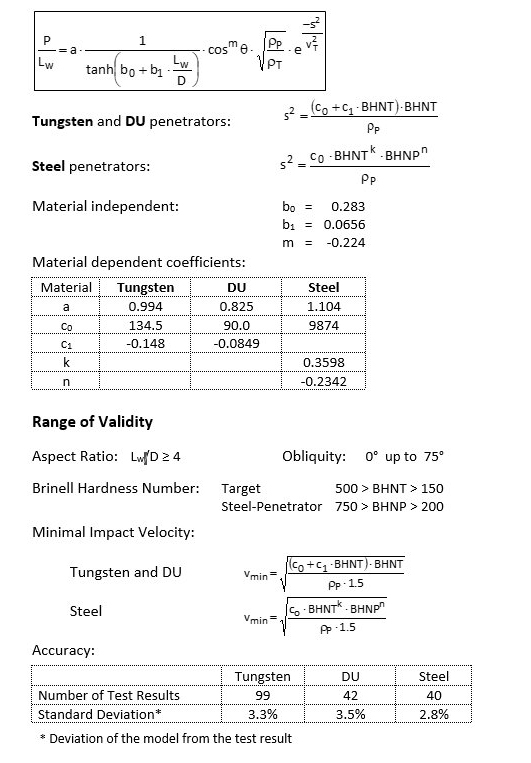
Vasemmalta valikosta voi selata eri osioita. Alla kaavan osatekijät graafisesti.
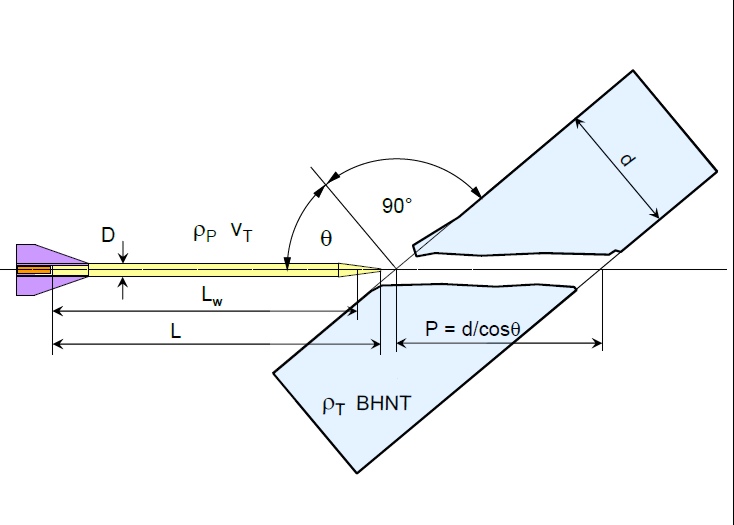
Alumiinissa on ongelma vain sen pehmeys.
Sekin, mutta suurempi ongelma on sen keveys.
Mielenkiintoinen näkemys.
http://below-the-turret-ring.blogspot.fi/2016/01/the-drawbacks-of-front-mounted-engines.html
The drawbacks of front-mounted engines in modern main battle tanks
The Merkava series of main battle tanks (MBTs) is currently the only real MBT with a front-mounted engine. On light tanks, armored personnel carriers (APCs), self-propelled guns (SPGs) and infantry fighting vehicles (IFVs) placing the engine infront of the crew compartment is a common design practice, but on main battle tanks this is a rarity.

The Merkava tanks with their front-mounted powerpacks are a modern oddity and rarity
The reason for this is that having a front-mounted engine comes with a rather huge number of drawbacks, compared to only a few advantages, which by most countries are not considered as mandatory improvments for a tank.
A front-mounted engine does have a number of drawbacks in regards to the tank's armor protection:

Additional length for the heavy ballistic skirts (red) and base armor (yellow) are needed on the Merkava to protect the crew (teal)
Compared to a Leopard 2, the Merkava has about 100 mm less ground clearance and an about 200 mm greater height to the turret roof. The height to the top of the UFP is about 300 mm larger on the Merkava, as measured on different photographs of the Merkava II and Merkava III.

This drawing of a M1 Abrams hull shows how the hull front is not as tall as the rear and thus the frontal profile can be kept smaller
While a powerpack and also fuel tanks will offer some amount of protection against impacting projectiles (although less than actual armor will - both per thickness and per weight), it should be taken into account that this is a different type of protection:
Once the powerpack is damaged from a projectile or the fuel systems are ignited, the tank will become imobile and won't be able to participate in any further combat actions. Instead of the crew dying, the damaged tank will be a mobility kill or a mission kill. This also means however that other parts of the forces have to secure the damaged tank and guard it until reinforcements or combat engineers have arrived - because otherwise the damaged tank will turn very easily into a total loss, when enemy forces attack it. In other words: a front-mounted engine can only provide crew protection, the tank as a system however will be even more susceptible to damage.
Actual armor on the other hand does not only crew protection, but also system protection. If an impacting projectile is stopped by the special armor, it won't be able to damage the internal components of the tank. The tank as a system stays intact and can still participate in combat.
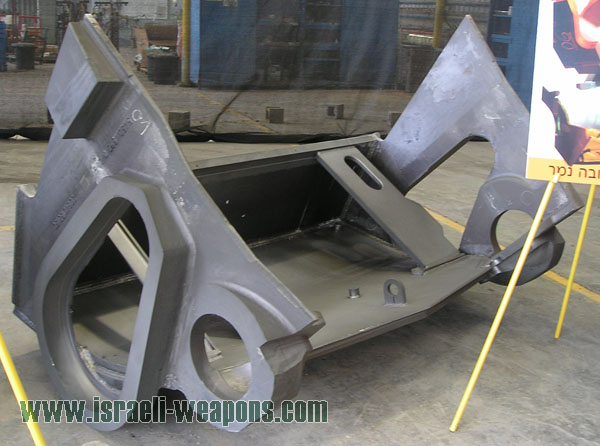
The lower front plate of the Merkava is protected by very thin armor only
Furthermore a number of negative performance features are interwoven with the decision to utilize a front-mounted powerpack in a modern tank. The driver's vision in close proximity is reduced, because he is located further away from the frontal edge of the hull and because the hull is taller. The static track tension will be higher. The drive sprokets located at the front are more exposed to rocks and other obstacles, which means at higher speeds the drive sprockets can be hit and will be damaged easier. Also the air-intakes and/or the exhaust vents have to be located at the sides of the hull or at the front, which will get clogged on dusty/sandy terrain more easily.
In case of infantry fighting vehicles and armored personnel carries, placing the powerpack in the front of the vehicle does offer a great benefit: a rear ramp/door - the infantry squad can enter and disembark from the vehicle without being exposed to enemy fire, while the thicker frontal armor of the vehicle can face the enemy. As there are currently not many purpose-built light tanks, most light tank designs are based on IFVs in order to keep costs down. Here placing the engine at the front means just saving costs compared to redesigning the hull and vehicle.
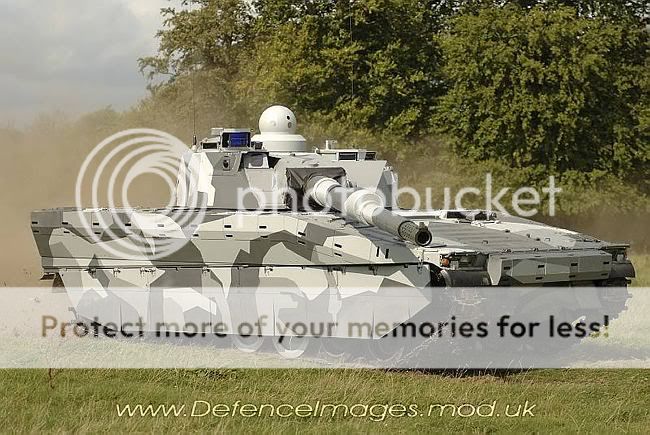
Like most modern light tanks, the CV90-120 just mounts a turret on the IFV chassis
For self-propelled guns placing the engine in the front of the vehicle is benefical, because the vehicle have a huge demand for ammunition (so a rear door for ammo replenishment is needed) and due to the extreme length of the gun barrels, which requires the turret to be placed further away from the front to reduce gun overhang and add stability while firing.
For the Merkava series the front-mounted engine made sense, when we look at it's history. Israel lacked modern armor technology and thus relied on spaced armor only. The armor layout of the Merkava I and II is optimized for hull-down combat from static positions, which was the most common type of operation for tanks during most of the Israel-Arab conflicts of the past, such as the Yom-Kippur War and the Six Days War. The weaker lower hull of the Merkava would be hidden behind the terrain or prepared (concrete reinforced) positions, so that the hitting them would not be possible. The lack of (bulky) composite armor also meant that no system protection is lost compared to a tank with homogenous or spaced armor and rear-mounted engine.

The frontal hull armor of a Merkava I or II tank. All armor is placed in front of the engine!
The later models of the Merkava series however suffer unnecessary weaknesses from their inheritance. At a 60-65 metric tons weight, but a larger physical size and a much larger armored surface (more armor required for the frontal surface, for the sides, the rear, the roof, aswell as for the mine-protection), the Merkava tanks should not be expected to be as well armored as their European or some of their Asian competitors.

Object 299 prototype tank - the front-mounted engine had a huge impact on mobility and maximum armor thickness.
All major tank building nations have experimented with tanks, which had their engines mounted in the front or in the center section of the tank. None of these experiments resulted in the adoption or creation of a new MBT with front-mounted powerpack.
http://below-the-turret-ring.blogspot.fi/2016/01/the-drawbacks-of-front-mounted-engines.html
The drawbacks of front-mounted engines in modern main battle tanks
The Merkava series of main battle tanks (MBTs) is currently the only real MBT with a front-mounted engine. On light tanks, armored personnel carriers (APCs), self-propelled guns (SPGs) and infantry fighting vehicles (IFVs) placing the engine infront of the crew compartment is a common design practice, but on main battle tanks this is a rarity.

The Merkava tanks with their front-mounted powerpacks are a modern oddity and rarity
The reason for this is that having a front-mounted engine comes with a rather huge number of drawbacks, compared to only a few advantages, which by most countries are not considered as mandatory improvments for a tank.
A front-mounted engine does have a number of drawbacks in regards to the tank's armor protection:
- A frontal engine reduces the space available for special armor
- Modern composite armor is very bulky and requires a lot of space (more than 600 milimetres for the hull on modern tanks) in order to deal with all available threats; a powerpack is taking up a lot more length (about 1500 mm for the MT 883 engine), but increasing the length of the tank's hull is not desireable, as it has a huge number of drawbacks. In case of the Merkava tank, the frontal hull armor is thinner than that of a comparable MBT from another country.
- It also increases hull height
- The height required for a seated driver (in a reclining position) is lower than the height required for a powerpack. In case of the German Leopard 2 MBT, the height at the start of the UFP (upper front plate) is about 1 metre above the ground. The height at the end of the UFP is about 1.522 metres above the ground, where the rear section of the hull where the powerpack is mounted, is located 1.774 metres above the ground: mounting the engine at the hull front would increase the height of the hull by 222 mm (or 272 mm if we include the difference in ground clearance between Leopard 2 hull front and rear). That's about half the size of the UFP!
- This also can lead to an increased turret height
Due to the higher hull and the turret ring being moved backwards (in comparison to other tanks), the turret has to be higher, unless a lower range for gun depression and elevation is deemed as acceptable. If the turret was not taller, the gun would hit the UFP everytime the crew tries to depress the gun. In case of the Merkava reducing the gun depression was chosen, so that the Mark IV has only 7° gun depression instead of the approximately 10° reached by other tanks with manned turrets.
- A front-mounted engines also means that more weight and volume of the special armor has to be utilized for reaching the same amount lateral protection

Additional length for the heavy ballistic skirts (red) and base armor (yellow) are needed on the Merkava to protect the crew (teal)
Compared to a Leopard 2, the Merkava has about 100 mm less ground clearance and an about 200 mm greater height to the turret roof. The height to the top of the UFP is about 300 mm larger on the Merkava, as measured on different photographs of the Merkava II and Merkava III.

This drawing of a M1 Abrams hull shows how the hull front is not as tall as the rear and thus the frontal profile can be kept smaller
While a powerpack and also fuel tanks will offer some amount of protection against impacting projectiles (although less than actual armor will - both per thickness and per weight), it should be taken into account that this is a different type of protection:
Once the powerpack is damaged from a projectile or the fuel systems are ignited, the tank will become imobile and won't be able to participate in any further combat actions. Instead of the crew dying, the damaged tank will be a mobility kill or a mission kill. This also means however that other parts of the forces have to secure the damaged tank and guard it until reinforcements or combat engineers have arrived - because otherwise the damaged tank will turn very easily into a total loss, when enemy forces attack it. In other words: a front-mounted engine can only provide crew protection, the tank as a system however will be even more susceptible to damage.
Actual armor on the other hand does not only crew protection, but also system protection. If an impacting projectile is stopped by the special armor, it won't be able to damage the internal components of the tank. The tank as a system stays intact and can still participate in combat.

The lower front plate of the Merkava is protected by very thin armor only
Furthermore a number of negative performance features are interwoven with the decision to utilize a front-mounted powerpack in a modern tank. The driver's vision in close proximity is reduced, because he is located further away from the frontal edge of the hull and because the hull is taller. The static track tension will be higher. The drive sprokets located at the front are more exposed to rocks and other obstacles, which means at higher speeds the drive sprockets can be hit and will be damaged easier. Also the air-intakes and/or the exhaust vents have to be located at the sides of the hull or at the front, which will get clogged on dusty/sandy terrain more easily.
In case of infantry fighting vehicles and armored personnel carries, placing the powerpack in the front of the vehicle does offer a great benefit: a rear ramp/door - the infantry squad can enter and disembark from the vehicle without being exposed to enemy fire, while the thicker frontal armor of the vehicle can face the enemy. As there are currently not many purpose-built light tanks, most light tank designs are based on IFVs in order to keep costs down. Here placing the engine at the front means just saving costs compared to redesigning the hull and vehicle.

Like most modern light tanks, the CV90-120 just mounts a turret on the IFV chassis
For self-propelled guns placing the engine in the front of the vehicle is benefical, because the vehicle have a huge demand for ammunition (so a rear door for ammo replenishment is needed) and due to the extreme length of the gun barrels, which requires the turret to be placed further away from the front to reduce gun overhang and add stability while firing.
For the Merkava series the front-mounted engine made sense, when we look at it's history. Israel lacked modern armor technology and thus relied on spaced armor only. The armor layout of the Merkava I and II is optimized for hull-down combat from static positions, which was the most common type of operation for tanks during most of the Israel-Arab conflicts of the past, such as the Yom-Kippur War and the Six Days War. The weaker lower hull of the Merkava would be hidden behind the terrain or prepared (concrete reinforced) positions, so that the hitting them would not be possible. The lack of (bulky) composite armor also meant that no system protection is lost compared to a tank with homogenous or spaced armor and rear-mounted engine.

The frontal hull armor of a Merkava I or II tank. All armor is placed in front of the engine!
The later models of the Merkava series however suffer unnecessary weaknesses from their inheritance. At a 60-65 metric tons weight, but a larger physical size and a much larger armored surface (more armor required for the frontal surface, for the sides, the rear, the roof, aswell as for the mine-protection), the Merkava tanks should not be expected to be as well armored as their European or some of their Asian competitors.

Object 299 prototype tank - the front-mounted engine had a huge impact on mobility and maximum armor thickness.
All major tank building nations have experimented with tanks, which had their engines mounted in the front or in the center section of the tank. None of these experiments resulted in the adoption or creation of a new MBT with front-mounted powerpack.
Yksinkertaisimman mallin mukaan:
http://eprints.maths.ox.ac.uk/211/1/poole.pdf
sivu 37 / 253 kaava (2.4)
läpäisy d = L * neliöjuuri (tiheys_jet / tiheys_target), jossa L on suihkun pituus.
Jos teräs korvataan tiheydeltään neljäsosalla, mutta samanpainoisella panssarilla, on se paksuudeltaan nelinkertainen teräkseen verrattuna, mutta läpäisy on vain kaksinkertainen, eli jos juuri ja juuri läpäisee teräksen, niin tiheydeltään pienemmällä panssarilla läpäisee vain puoleen väliin asti.
Tiheydeltään alhainen materiaali on siis parempi, eikä huonompi, kun panssarin paksuutta rajoittaa paino, eikä käytettävissä oleva tila, ja kun tarkoitus on torjua onteloammuksia.
Moottorin vesitilavuuden voivat siis olla merkityksellisiä, mikäli ovat riittävän paksuja, eli 100 mm terästä vastaa onteloammuksen kannalta 280 mm vettä, mikä painaa saman verran kuin 36 mm terästä. Ei ole siis ollenkaan sama kuin vastaava paksuus ilmaa ...
Tuosta lähteestä löytyy kyllä kaavoja ihan riittävästi jokaiseen makuun, mutta tulokset näkyy kuvistakin joita on myös aika paljon.
Ps, en sitten väitä mitään siitä kuinka paksuja vesitilavuuksia jossain panssarissa ihan oikeasti on, syystä etten ko asiasta paljoakaan tiedä, mutta periaatteessa sillä saavutetaan painonsäästöjä samalla läpäisyllä.
Tulipahan mieleen, että BMP-3:een laittoivat polttoainetankin keulaan etupanssarin suojaa lisäämään. Joten kai sillä joku vaikutus on.

